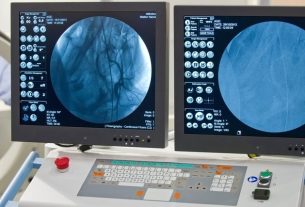Hemoglobin, or Hb, is a protein that is part of red blood cells and whose main function is to transport oxygen to all tissues of the body.
The concentration of hemoglobin in red blood cells can be measured using a conventional blood test, the CBC, or using a rapid measuring device, similar to the diabetes device. Thus, according to the amount of hemoglobin present in the red blood cell and the results of other hematological tests, it is possible to know the person’s general health status.
In general, high hemoglobin can be a consequence of dehydration, tobacco use or pulmonary emphysema, while a decrease in the amount of hemoglobin is usually related to anemia, thalassemia or a consequence of hemorrhage, for example.

Types of hemoglobin
Hemoglobin can be classified into some types according to its constituents:
- HbA1: is formed by the heme group (Hb) with two alpha chains and two beta chains, being present in higher concentrations in the blood;
- HbA2: is formed by the heme group (Hb) with two alpha chains and two delta chains;
- HbF: is formed by the heme group (Hb) with two alpha chains and two gamma chains. It is present in higher concentrations in newborns.
There are also types: Hb Gower I, Gower II and Portland, which are present during embryonic life, with a decrease in concentration and an increase in HbF as birth approaches.
The type of hemoglobin is identified through hemoglobin electrophoresis, which is also useful in diagnosing diseases related to hemoglobin synthesis. Understand how hemoglobin electrophoresis is performed.
Hemoglobin reference values
The hemoglobin reference values are:
- Children aged 2 to 6 years: 11,5 a 13,5 g/dL;
- Children aged 6 to 12: 11,5 a 15,5 g/dL;
- Men: 14 a 18 g/dL;
- Women: 12 a 16 g/dL;
- Pregnant women: 11 g/dL.
The hemoglobin concentration is measured through the blood count, which indicates, in addition to hemoglobin, the quantity of red blood cells and other indices, such as MCV, HCM and MCHC, which must be evaluated together. Learn more about the blood count.
Do you have questions about your exam results?
If you recently had a blood test and want to know what it could mean, enter your data into the calculator below:
What does high hemoglobin mean?
High hemoglobin in the blood can be caused by:
- Tobacco use;
- Dehydration;
- Pulmonary emphysema;
- Pulmonary fibrosis;
- Polycythemia;
- Tumor nos rins;
- Use of anabolic steroids or the hormone erythropoietin.
High hemoglobin is characterized by symptoms such as dizziness, bluish skin on the lips and fingertips and, in rarer cases, temporary loss of vision and hearing.
What does low hemoglobin mean?
A decrease in the amount of hemoglobin can occur in the case of anemia, cirrhosis, lymphoma, leukemia, hypothyroidism, kidney failure, thalassemia, porphyria and hemorrhage, for example. Furthermore, low hemoglobin can also occur due to iron and vitamin deficiency, in addition to the use of medications to treat cancer and AIDS, for example.
A low number of hemoglobin in the blood can cause symptoms such as frequent tiredness, shortness of breath and paleness, and the cause must be identified and treatment initiated according to medical advice.
Bibliography
- NATIONAL QUALITY CONTROL PROGRAM. Hematological reference values for adults and children. 2020. Available at: <https://pncq.org.br/wp-content/uploads/2021/04/VRH2020.pdf>. Accessed on Feb 22, 2023
- ROSENFELD, Luiz G.; MALTALL, Deborah C.; SZWARCWLD, Célia L. et al. Reference values for laboratory blood count tests for the Brazilian adult population: National Health Survey. Brazilian Journal of Epidemiology. Vol 22. 2 ed; 2019

Sign up for our newsletter and stay up to date with exclusive news
that can transform your routine!
Warning: Undefined array key "title" in /home/storelat/public_html/wp-content/plugins/link-whisper-premium/templates/frontend/related-posts.php on line 12
Warning: Undefined array key "title_tag" in /home/storelat/public_html/wp-content/plugins/link-whisper-premium/templates/frontend/related-posts.php on line 13




